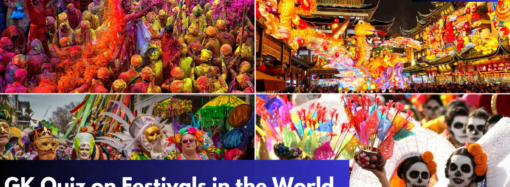GK Quiz on Periodic Table

GK Quiz on Periodic Table
What is a Periodic Table?
GK Quiz on Periodic Table | The Periodic Table is a tabulated display of chemical elements. In the Modern Periodic Table, the elements are arranged by atomic number, electron configuration, and recurring chemical properties. The Periodic Table is used for predicting properties of discovered and undiscovered elements. It is also useful in sorting elements in a sensible way by grouping them with other elements with similar properties to understand and find them quicker.
The main purpose of the periodic table is to organize the similarities and properties of the elements in a way that can help us visualize and categorize the materials around us.
GK Quiz on Periodic Table
1. The rows in Periodic Table are called __________.
a) Classes
b) Periods
c) Chemicals
d) Blocks
2. Which one of the following elements is very rare?
a) Thorium
b) Uranium
c) Francium
d) Nihonium
3. In Periodic Table, elements are arranged in left to right fashion in each row, based on ________.
a) Number of protons in their nucleus
b) Number of electrons in their nucleus
c) Number of neutrons in their nucleus
d) All the above
4. The columns of the Periodic Table is called ______.
a) Classes
b) Groups
c) Divisions
d) Grades
5. The noble or inert gases are lined up in the ________ column of the periodic table.
a) Sixteenth
b) Seventeenth
c) Eighteenth
d) Nineteenth
6. Periodic Table was formulated by _________.
a) Henry Moseley
b) Antoine Lavoisier
c) John Newlands
d) Dmitri Mendeleev
7. Which element in the Periodic Table has the highest atomic number and highest atomic mass of all known elements?
a) Oganesson
b) Livermorium
c) Tellurium
d) Rhenium
8. Which of the following statements are TRUE?
a) The first 94 elements in Periodic Table occur naturally
b) Elements 95 to 118 have only been synthesized in laboratories or nuclear reactors.
c) Alkali Metals occupy the left-most column of the Periodic Table.
d) All are True
9. ________ was the first man-made or artificially produced element.
a) Roentgenium
b) Nihonium
c) Technetium
d) Tantalum
10. _________ is responsible for maintaining the periodic table.
a) IUPAC
b) IUCN
c) IUPAP
d) PubChem
11. Who proposed Law of Triads?
a) Dobereiner
b) John Newlands
c) Lothan Grenger
d) Michal Philip Gardener
12. Reactive metals with low ionization enthalpies belong to _____________.
a) s-Block Elements
b) p-Block Elements
c) d-Block Elements
d) f-Block ELements
13. Which of the following statements are TRUE about d-Block Elements?
a) These are the elements of Group 3 to 12 in the centre of the Periodic Table
b) They are all metals.
c) They are also known as “Transition Elements”.
d) All are TRUE.
14. Which of the following statements are TRUE about f-Block Elements?
a) These are the elements from two rows at the bottom of the Periodic Table.
b) Lanthanoids & Actinoids belong to f-Block Elements.
c) They are also known as “Inner-Transition Elements”.
d) All are TRUE.
15. What are the elements named by Lawrence Berkeley national laboratory?
a) Lawrencium
b) Berkelium
c) Both a) and b)
d) None of the above
16. In the modern periodic table, the period indicates the value of __________.
a) Atomic number
b) Atomic mass
c) Principal quantum number
d) Azimuthal quantum number






